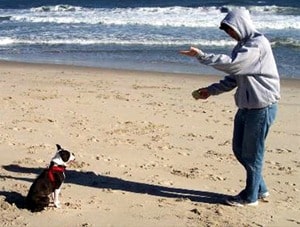Dogs communicate with each other mainly through scent and body language. When two dogs greet each other they are communicating all kinds of signals, without needing sound. Sounds such as barking and growling are additional ways to communicate but they are not their primary source of communication; therefore verbal language is not necessary to train a dog. In fact dogs read cues in our body language, and expression in our face and eyes even more than what we are saying to them.
When training any dog a new command the most important factors are to be clear in what you are asking your dog to do and to reward for the correct behavior. To train a dog to come you first get their attention; encourage them to come to you and praise when they reach you. Deaf dogs learn the same way but instead of relying on hearing your command they will be seeing it. Using hand signals is a good way to replace your voice. Some people choose to use hand signals similar to American sign language, but whatever you choose to use make sure it is consistent.
Teaching your deaf dog to come on command

Here are the steps to follow when teaching your deaf dog to come on command:
Get your dogs attention. To get your deaf dogs attention you can use any of the following methods: thump on the floor, wave your hands, or use a light such as a flashlight or laser light. There is also a vibrating collar available (NOT a shock collar) that releases a very gentle vibration to gain the attention of your dog.
Offer your hand signal. Once you have your dogs attention you’ll want to use your hand signal and look very tempting to get to with your expression and by offering a small, delicious food treat, such as cooked, cut up chicken breast. One suggestion for a hand signal would be to outstretch one arm, palm of your hand up, and in one swooping motion bring it back towards you, sort of like waving your dog over to you. If your dog doesn’t come to you try squatting down with arms outstretched like they will get a big hug when they reach you or even try running away from them as this often elicits a play response from your dog that makes them want to chase you.
Reward when they reach you. Once they reach you offer the food treat and lots of physical, joyous praise.
Repeat. You’ll want to repeat these steps several times daily. Start practicing in the home with very little distractions and as your dog gets better try adding more distractions. If you find your dog is running right past you or not coming, you can attach a long leash to them that allows you to get a hold of them and encourage them to get to you that way. Make sure you are looking very enticing to get to and rewarding the instant they reach you.
Teaching your deaf dog to stay on command

The Stay. Have your dog sit or lie down and give them a hand signal to stay; such as the palm of your hand in front of their face, like you are signaling someone to stop. Use a serious expression with direct eye contact. Then smile and give them an immediate delicious treat, such as cooked, cut up chicken breast. Make sure they are maintaining the stay while you treat. Then, give them another hand signal to stay and repeat the treat.
Release. You want your dog to understand the difference between maintaining a stay and being allowed to move so you’ll want to teach a release command that tells your dog it is now free to move. Give a release signal by raising your hands up in the air and giving a very enthusiastic expression to your face. Your dog should now move out of the stay position and hopefully move towards you for some praise.
Repeat. Continue to practice step one and begin to increase the time between giving the hand signal and offering the treat so that your dog is expected to maintain the stay for longer and longer periods of time. As with all beginning obedience practice first in areas with no distractions and gradually build up to more distractions.
Even though your dog may be deaf it is important that you have the same good behavioral expectations you would of any dog. Don’t make the mistake of allowing negative behaviors in your dog because you feel sorry for them. A well-trained dog is happier because they get to spend more time with you and the family. As with all dogs, your dog will be happier to live in a home that has consistent expectations of them.
